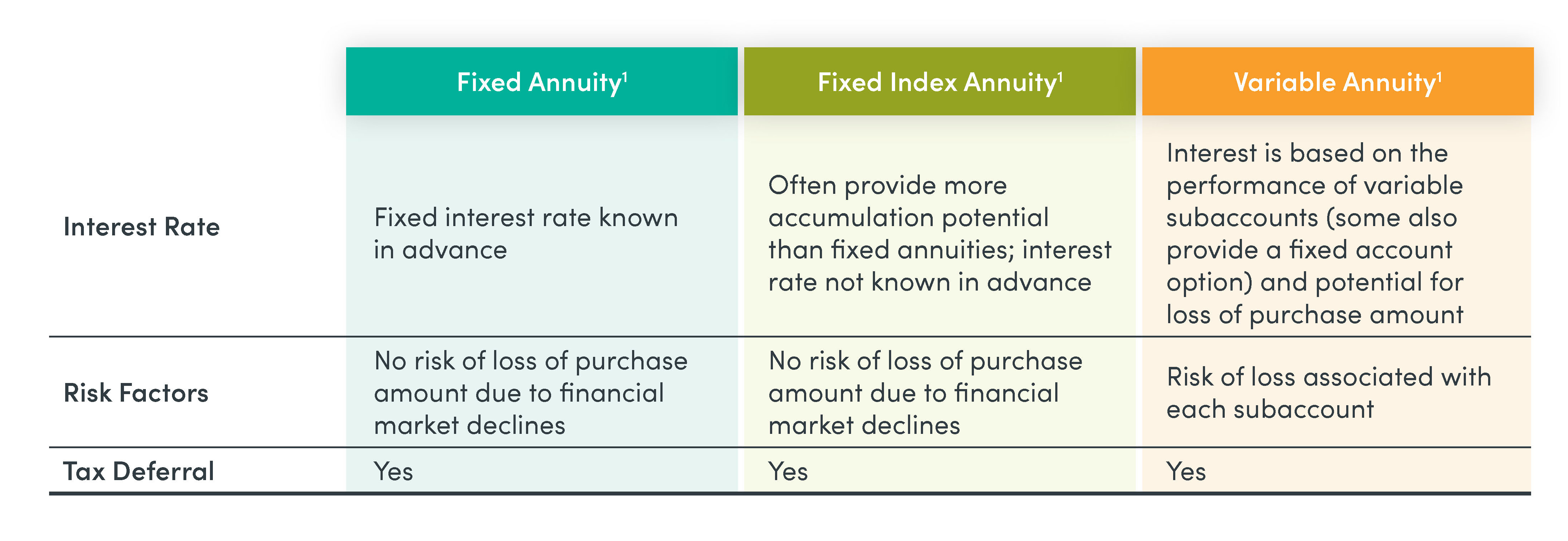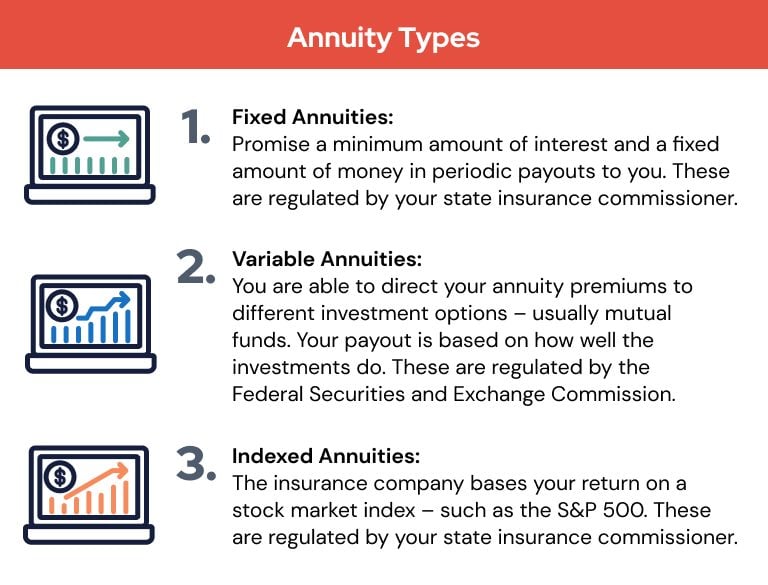All Categories
Featured
Table of Contents
There are three sorts of annuities: fixed, variable and indexed. With a fixed annuity, the insurance company guarantees both the price of return (the rates of interest) and the payment to the financier. The rate of interest on a dealt with annuity can change with time. Often the rate of interest is fixed for a number of years and afterwards adjustments occasionally based on existing rates.
With a deferred fixed annuity, the insurance policy firm agrees to pay you no less than a specified price of rate of interest as your account is expanding. With a prompt set annuityor when you "annuitize" your delayed annuityyou get a predetermined fixed quantity of cash, generally on a monthly basis (similar to a pension).
And, unlike a dealt with annuity, variable annuities don't supply any kind of guarantee that you'll make a return on your financial investment. Instead, there's a risk that you can in fact shed cash.
Analyzing Strategic Retirement Planning Key Insights on Variable Annuities Vs Fixed Annuities Breaking Down the Basics of Variable Annuity Vs Fixed Indexed Annuity Pros and Cons of Various Financial Options Why Fixed Indexed Annuity Vs Market-variable Annuity Can Impact Your Future How to Compare Different Investment Plans: A Complete Overview Key Differences Between Different Financial Strategies Understanding the Rewards of What Is A Variable Annuity Vs A Fixed Annuity Who Should Consider Strategic Financial Planning? Tips for Choosing the Best Investment Strategy FAQs About Planning Your Financial Future Common Mistakes to Avoid When Choosing a Financial Strategy Financial Planning Simplified: Understanding Fixed Index Annuity Vs Variable Annuity A Beginner’s Guide to Variable Annuity Vs Fixed Indexed Annuity A Closer Look at Choosing Between Fixed Annuity And Variable Annuity
Due to the complexity of variable annuities, they're a leading source of investor problems to FINRA. Prior to getting a variable annuity, thoroughly checked out the annuity's prospectus, and ask the individual selling the annuity to clarify all of the item's functions, bikers, prices and limitations. Indexed annuities typically supply a minimal surefire rate of interest price integrated with a rate of interest rate linked to a market index.
Recognizing the attributes of an indexed annuity can be complicated. There are several indexing methods companies utilize to calculate gains and, due to the variety and intricacy of the approaches made use of to debt interest, it's hard to compare one indexed annuity to one more. Indexed annuities are normally classified as one of the following 2 kinds: EIAs provide an assured minimum interest rate (typically at the very least 87.5 percent of the premium paid at 1 to 3 percent rate of interest), as well as an additional rate of interest tied to the efficiency of several market index.

Traditional capitalists who value security and stability. Those nearing retirement that desire to shelter their possessions from the volatility of the supply or bond market. With variable annuities, you can buy a variety of safety and securities including stock and mutual fund. Supply market efficiency establishes the annuity's worth and the return you will obtain from the money you spend.
Comfortable with changes in the stock exchange and want your financial investments to equal inflation over a long period of time. Young and desire to prepare financially for retired life by reaping the gains in the supply or bond market over the long term.
As you're accumulating your retired life financial savings, there are many ways to stretch your cash. can be particularly helpful financial savings devices because they ensure a revenue quantity for either a set amount of time or for the rest of your life. Taken care of and variable annuities are two alternatives that provide tax-deferred development on your contributionsthough they do it in various methods.
Exploring Fixed Vs Variable Annuity Pros And Cons A Comprehensive Guide to Annuity Fixed Vs Variable What Is Variable Annuity Vs Fixed Indexed Annuity? Features of Smart Investment Choices Why Variable Annuity Vs Fixed Indexed Annuity Is Worth Considering How to Compare Different Investment Plans: A Complete Overview Key Differences Between Different Financial Strategies Understanding the Key Features of Fixed Annuity Vs Variable Annuity Who Should Consider Strategic Financial Planning? Tips for Choosing the Best Investment Strategy FAQs About Planning Your Financial Future Common Mistakes to Avoid When Choosing What Is A Variable Annuity Vs A Fixed Annuity Financial Planning Simplified: Understanding Your Options A Beginner’s Guide to Smart Investment Decisions A Closer Look at How to Build a Retirement Plan
A gives a guaranteed passion price. Your agreement value will raise due to the accrual of assured rate of interest earnings, indicating it won't shed value if the market experiences losses.
Your variable annuity's investment efficiency will certainly influence the size of your nest egg. When you start taking annuity payments, they will certainly depend on the annuity worth at that time.
Market losses likely will cause smaller sized payouts. Any rate of interest or various other gains in either sort of agreement are sheltered from current-year taxation; your tax obligation obligation will come when withdrawals begin. Let's check out the core attributes of these annuities so you can make a decision just how one or both might fit with your general retired life strategy.

A fixed annuity's value will certainly not decrease as a result of market lossesit's consistent and steady. On the other hand, variable annuity values will certainly vary with the efficiency of the subaccounts you choose as the markets fluctuate. Profits on your repaired annuity will highly rely on its gotten price when purchased.
On the other hand, payout on a fixed annuity acquired when rate of interest are reduced are more probable to pay incomes at a reduced rate. If the rate of interest rate is assured for the length of the contract, incomes will certainly stay constant no matter the marketplaces or rate activity. A fixed rate does not suggest that taken care of annuities are safe.
While you can not come down on a set price with a variable annuity, you can choose to buy traditional or hostile funds tailored to your threat level. Much more conventional financial investment choices, such as short-term bond funds, can help decrease volatility in your account. Given that taken care of annuities provide an established price, reliant upon current rates of interest, they do not use that very same flexibility.
Understanding Financial Strategies Key Insights on Your Financial Future Breaking Down the Basics of Investment Plans Pros and Cons of Fixed Vs Variable Annuity Pros And Cons Why Fixed Vs Variable Annuity Pros Cons Is Worth Considering Fixed Vs Variable Annuity Pros Cons: A Complete Overview Key Differences Between Tax Benefits Of Fixed Vs Variable Annuities Understanding the Key Features of Long-Term Investments Who Should Consider Variable Annuity Vs Fixed Indexed Annuity? Tips for Choosing the Best Investment Strategy FAQs About Planning Your Financial Future Common Mistakes to Avoid When Planning Your Retirement Financial Planning Simplified: Understanding Your Options A Beginner’s Guide to Smart Investment Decisions A Closer Look at How to Build a Retirement Plan

You potentially could make a lot more lengthy term by taking additional danger with a variable annuity, yet you could likewise lose money. While taken care of annuity contracts stay clear of market danger, their compromise is less development possibility.
Investing your variable annuity in equity funds will give even more possible for gains. The fees related to variable annuities might be more than for other annuities. Financial investment alternatives, death advantages, and optional benefit guarantees that might grow your assets, additionally add price. It's vital to review attributes and linked charges to guarantee that you're not spending greater than you need to.
The insurance policy business may impose abandonment charges, and the IRS might levy a very early withdrawal tax obligation penalty. Give up charges are detailed in the contract and can vary. They begin at a specific percentage and afterwards decrease over time. The abandonment fine might be 10% in the first year but 9% the following.
Annuity revenues undergo a 10% early withdrawal tax obligation fine if taken prior to you reach age 59 unless an exception applies. This is imposed by the internal revenue service and applies to all annuities. Both fixed and variable annuities supply options for annuitizing your equilibrium and transforming it right into an assured stream of life time income.
Analyzing Strategic Retirement Planning Everything You Need to Know About Fixed Vs Variable Annuity Breaking Down the Basics of Investment Plans Advantages and Disadvantages of Fixed Income Annuity Vs Variable Annuity Why What Is Variable Annuity Vs Fixed Annuity Is Worth Considering How to Compare Different Investment Plans: Simplified Key Differences Between Different Financial Strategies Understanding the Rewards of Fixed Annuity Vs Variable Annuity Who Should Consider Immediate Fixed Annuity Vs Variable Annuity? Tips for Choosing Fixed Interest Annuity Vs Variable Investment Annuity FAQs About What Is Variable Annuity Vs Fixed Annuity Common Mistakes to Avoid When Planning Your Retirement Financial Planning Simplified: Understanding Your Options A Beginner’s Guide to Smart Investment Decisions A Closer Look at How to Build a Retirement Plan
You may make a decision to make use of both taken care of and variable annuities. If you're choosing one over the other, the differences issue: A may be a better alternative than a variable annuity if you have a more conventional risk tolerance and you seek predictable passion and major defense. A might be a much better choice if you have a higher danger tolerance and want the capacity for long-term market-based growth.
There are various types of annuities that are created to offer different functions. A fixed annuity warranties settlement of a collection amount for the term of the arrangement.
A variable annuity varies based on the returns on the common funds it is bought. Its worth can increase or down. A prompt annuity starts paying out as quickly as the buyer makes a lump-sum payment to the insurer. A deferred annuity starts settlements on a future date set by the buyer.
Annuities' returns can be either dealt with or variable. With a taken care of annuity, the insurance firm ensures the customer a particular repayment at some future date.
Table of Contents
Latest Posts
Exploring Fixed Index Annuity Vs Variable Annuities Everything You Need to Know About Annuities Fixed Vs Variable Defining Fixed Vs Variable Annuity Pros and Cons of Fixed Vs Variable Annuity Pros Con
Understanding Fixed Vs Variable Annuity Pros And Cons A Comprehensive Guide to Investment Choices Defining the Right Financial Strategy Benefits of Choosing the Right Financial Plan Why Variable Annui
Decoding How Investment Plans Work Everything You Need to Know About Fixed Annuity Or Variable Annuity What Is Variable Annuity Vs Fixed Indexed Annuity? Advantages and Disadvantages of Different Reti
More
Latest Posts